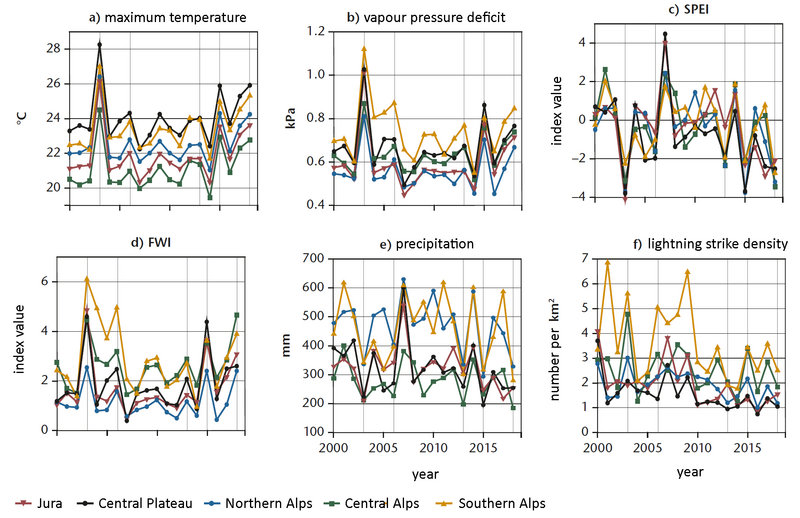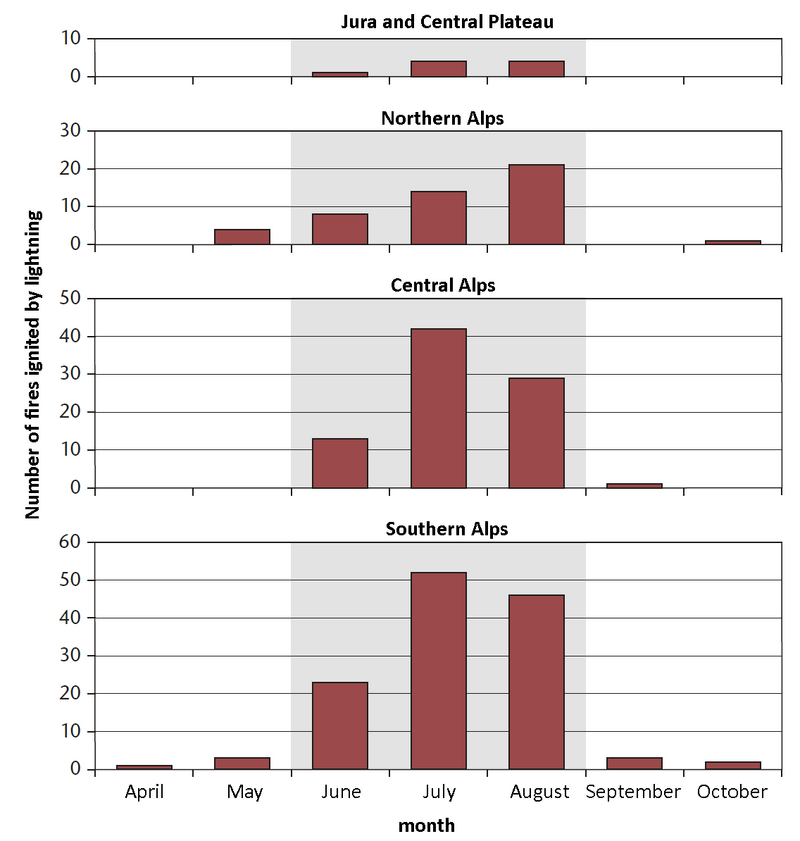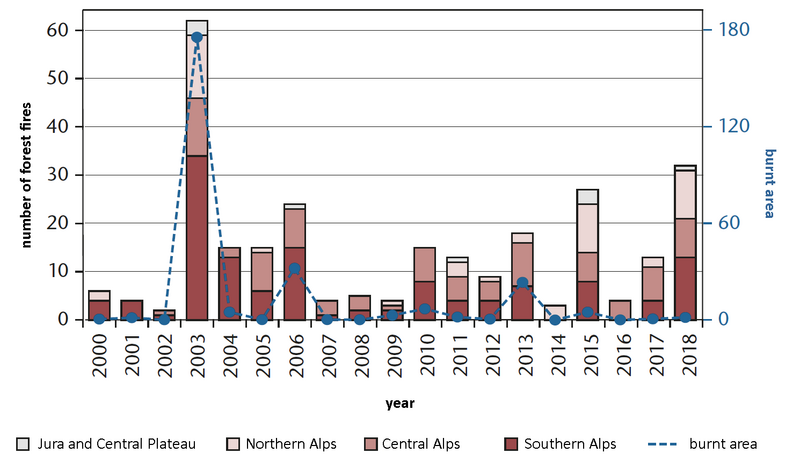Lightning strikes are the main natural cause of forest fires worldwide. In many forest ecosystems, they are the main driver of stand dynamics and succession. In the boreal forests of North America, the majority of fires and burnt areas can for example be attributed to lightning strikes.
In Europe, the proportion of forest fires caused by lightning strikes is smaller, due to the greater human influence. In the highly fire-prone Mediterranean region, lightning-induced fires account for a maximum of 5% of the total number of forest fires. The proportion of lightning-induced fires in the boreal forests of northern Europe is around 10%. In Switzerland, the average proportion of lightning-induced fires annually in the period 2000 to 2018 was 12.3%, but it was 30.5% in high summer (June, July and August), which is certainly comparable with other Alpine regions.
Lightning-induced fires and those caused by human activity in the Alps differ in various respects. Fires caused by human actions are most common in spring, before the start of the growing season (March to April), whereas lightning-induced fires mainly occur in high summer.
Lightning-ignited fires mainly affect coniferous forests in steeper terrain and at higher altitudes. These fires usually ignite as underground, smouldering fires in the raw humus, with the survival phase (the so-called holdover time) lasting last one to two weeks before the fire transitions to the visible, above-ground combustion phase. As a result of these typical characteristics - underground fire hotspots in remote and steep areas - fires ignited by lightning are challenging for fire brigades to extinguish (Fig. 1).

Fig. 1: Development of a fire caused by lightning in the mountains. Top: lightning strike on 19 July 2013 in Valle d'Arbedo (Ticino). Centre: fire outbreak on 20 July 2013 on an inaccessible rocky outcrop covered with deciduous trees. Bottom: firefighting operation by helicopter. Photos: Franjo Martinovic
The occurrence of forest fires caused by lightning is closely related to:
- the existing vegetation (e.g. proportion of conifers),
- the dead biomass arising from this (e.g. compact and flammable litter layer),
- the topographical conditions (e.g. hilltop locations that attract lightning)
- and, in particular, the prevailing meteorological conditions (periods of drought or lack of precipitation, followed by thunderstorms with lightning strikes on the ground).
It is therefore reasonable to assume that drought-induced fires started by lightning strikes will increase in the future as a result of global change and climate change. Scientists at the Swiss Federal Institute for Forest, Snow and Landscape Research WSL have therefore carried out a study to analyse the incidence of forest fires caused by lightning in Switzerland.
Data sources
All fires between 2000 and 2018 that were recorded in the “Swissfire” forest fire database and caused by lightning were included in the study (Fig. 2).
The recorded data on flashes of lightning in the whole of Switzerland for the same period comes from the “European Cooperation for Lightning Detection” network (EUCLID). For the purposes of the study, only lightning strikes that reached the ground (so-called ground lightning) were taken into account. Their impact location can now be determined to an accuracy of around 100 metres.
The meteorological data come from MeteoSwiss measuring stations, which were selected on the basis of their location, lightning strike activity in the surrounding area (location and altitude range with the most lightning-induced fires in the corresponding region) and data availability for the study period (2000-2018). There are 29 stations in total: 6 for the Southern Alps, 10 for the Central Alps, 9 for the Northern Alps, 1 for the Central Plateau and 3 for the Jura (Fig. 2).

Fig. 2: Location of the meteorological stations used and the registered fires caused by lightning for the period 2000-2018. Red triangles: locations of fire outbreaks caused by lightning; black dots: MeteoSwiss meteorological stations. The names of the measuring stations can be found in the original article.
Results
A total of 275 fires caused by lightning were recorded in the Swissfire forest fire database for the period 2000-2018. The highest number and density of lightning-induced fires occurred in the Southern Alps (Sopraceneri and Moesano), followed by the Central Alps and the Northern Alps (Figs. 2 and 3). In the Central Alps, a certain concentration can be observed in the Upper Valais (Goms) and in the Grisons Rhine Valley around Thusis (Tosana). Lightning-induced fires occurred very rarely in the Jura and the Central Plateau.
There are also small differences between the regions in the distribution of lightning-ignited fires during high summer. While the frequency of lightning-induced fires in the Southern and Central Alps rose sharply from June to July, this was not the case in the other regions (Fig. 3).
In 170 of the 275 fires (61%), the degree of species mixture in the forest stand was known. Making up a share of 77%, pure coniferous forests were by far the most frequently affected by lightning-induced fires. 7% of the fires were recorded in mixed stands and 16% were recorded in pure deciduous forests. Among the conifers, it was mainly spruce and larch that were affected, while beech and sweet chestnut were the main deciduous trees affected.
The occurrence of lightning-induced fires varies greatly from year to year (Fig. 4). Some years stand out in terms of both the number and area of fires (2003, 2006), others only in terms of the number (2015, 2018), or the area (2013). In some of these years, there were also fires caused by lightning on the Central Plateau (2003, 2015, 2018) and/or in the Jura (2003, 2006, 2015).
In all these years in which lightning-induced fires occurred, certain meteorological parameters that are directly or indirectly associated with drought were noticeable in high summer (June, July and August). These parameters are the average maximum temperature (Fig. 5a) and the average vapour pressure deficit (Fig. 5b), both of which were considerably elevated in these years. The two dryness indices SPEI and FWI also showed clear deficits (Fig. 5c and 5d). The relationship with total precipitation was less clear, even though this was rather low in the lightning-induced fire years (Fig. 5e).
There was no direct correlation with the density of lightning strikes: this was high in certain years with lightning-induced fires (e.g. 2003), but low in others (e.g. 2013; Fig. 5f). The data on lightning strike density in Fig. 5f must also be viewed with caution, as the differentiation between lightning types (ground lightning or cloud lightning) has improved considerably since 2011 thanks to the commissioning of additional measuring antennas. This could for example explain the generally lower lightning strike density on the southern side of the Alps since 2011.

Fig. 5: Selected meteoparameters and derived indices in high summer (June, July, August) from 2000 to 2018 in the biogeographical regions. a) Mean maximum temperature, b) vapour pressure deficit, c) SPEI-1 month (monthly standardised precipitation- evapotranspiration index), d) mean FWI (Canadian fire weather index), e) total precipitation and f) lightning strike density. The figures reflect the mean values of the weather stations used per region. In the figures, the lightning strike years 2003, 2006, 2013, 2015 and 2018 are marked with vertical lines.
The connection between summer drought and the incidence of forest fires caused by lightning only really becomes clear when selected meteorological variables are compared with the number of fires or with the size of the burnt area in the respective years in the various Alpine regions (Northern, Central and Southern Alps; Tab. 1, in German) or in the entire Alpine region (Tab. 1, in German, Fig. 6, in German). The number of fires shows a very strong correlation with both the vapour pressure deficit and the Canadian fire weather index (FWI). The correlation with the size of the burnt area is somewhat weaker, but also high. All four curves rise exponentially and show that the drier the summer, the greater the increase in the number of forest fires and, above all, in the size of the area affected. The extreme summer of 2003 had a major influence on the curves for the number of fires.
The bottom line
Fires caused by lightning strikes occur almost exclusively in mountainous terrain. In Switzerland, this mainly means steep and domed areas of the southern and central Alps, dominated by conifers, which attract lightning and have a strong tendency to dry out. Due to local thermo-orographic air convection, summer thunderstorms often occur in such locations. The lack of a strong orographic gradient could explain the low number of lightning-induced fires on the Central Plateau and to some extent also in the Jura.
The highly variable number of lightning-induced fires from year to year shows that persistent summer drought is by far the most important triggering factor for such forest fires. As for the boreal forests in western North America, a great deal of the annual variability in the incidence of lightning-induced fires in the Swiss Alps can be explained using simple drought-related parameters such as the vapour pressure deficit. The number and above all the size of the area affected by lightning-induced fires increases exponentially with increasing drought. Only during high or extreme levels of summer drought do lightning-induced fires also occur in the Jura and Central Plateau regions.
Dry periods with many fires caused by lightning are nothing new for the Alps: There were several such periods in the last century, for example:
- in Ticino in 1976 and 1990 (number of fires and area affected) and 1991 (number of fires only)
- in the Grisons (Graubünden) in 1983 (more the area affected by fire ) and 1984 (number of fires)
- in Valais in 1976 and 1993 (number of fires)
Whether it is the number of fires (e.g. in the high summers of 2003, 2006, 2015 and 2018) or the area affected by fires (2003, 2006, 2013) that shoots upwards probably depends on the timing, duration, severity and spatial spread of the drought (e.g. over the entire Alpine region). The frequency and severity of summer droughts certainly help to explain the south-north gradient in the frequency of fire caused by lightning in the Alps.
Based on the results presented, it can be assumed that the predicted increase in dry periods coupled with high temperatures in summer as a result of climate change will significantly increase the risk of lightning-induced fires in the Swiss Alps, and that the Jura and the Central Plateau may also be affected by fires cause by lightning during such periods.
Translation: Tessa Feller





